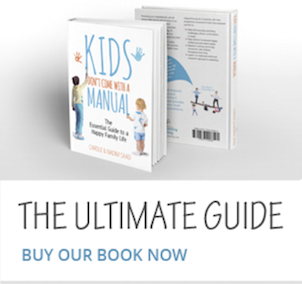It is often said that opposites attract, which is why when a couple fall in love they are often attracted by the very qualities that they lack in themselves. However, what we often don’t realise is how many conflicts these differences can cause when we start trying to raise children together!
This was certainly true of us as a couple; one of us, Nadim, had a more authoritarian nature, tending towards the stricter end of the spectrum whilst the other, Carole, had a more intuitive, laissez-faire approach to life. The moment that we had a family of our own, our two characters, which had once seemed so complimentary, began to clash over which parenting style we wanted to use on our own children.
It was our attempts to reconcile these two opposing styles, in order to form a united voice for our children, which lead us to investigate what scientific research revealed about the pros and cons of each parenting styles. The evidence we uncovered gave us an invaluable insight into our identities: as individuals, as a couple and as a family. In fact our discoveries proved so helpful that we decided to develop this new found knowledge to create a series of tools and techniques designed to smooth out the edges and harmonise parenting styles for parents at large.
The key finding that our research revealed is that parents tend to fall into one of three styles of parenting. Revealingly, although perhaps not surprisingly, this default parenting style is the result of our own experience of having been parented ourselves. In other words we are preconditioned to either choose, or rebel against, the way that we were “parented”.
What is your parenting style?
In order to be able to identify precisely which parenting style we have, we need to think of how we react to our kids when we feel most stressed by their misbehaviour. For it is when we are ‘up against it’ that our ‘natural’ parenting style really begins to reveal itself.
The first of these parenting styles is the more traditional strict/authoritarian method. Strict parents tend to parent according to firm rules, which may have been inherited from their own parents, or simply from a cultural style of parenting that goes back millennia. The Strict parent usually believes that without strict guidelines to adhere to, children will fail to learn essential values, including the correct way to behave. Although these Strict parents love their children as much as any other parent, they often prioritise the strict guidelines at the expense of a “smoother” relationship with their children in the short term. Children of Strict parents are expected to obey and abide by commands or rules and those who do not obey the rules can expect punishment. Questioning the rules, or helping to establish them, is not usually an option for these children. Although ultra Strict parents may resort to violence, most Strict parents simply focus on their “power” and authority over their children (rather than prioritising empathy) in order to get the respect that they expect.
The second style is what we call the “All Heart” parent. All Heart parents are trying hard to be the best parent possible and want to preserve the relationship with their children at all cost. These parents usually fear that when they impose harsh limits, make demands of their children or don’t give their kids what they want (particularly during a tantrum), that they may be hurting them. They are sometimes also called “Helicopter” parents because they are often over-protecting their children by “rescuing” them from situations (for eg. when they forget something). Above all the All Heart parents want to protect their children from negative emotions in order that their children stay happy.
There are also many parents who will “oscillate” between one extreme and another, depending on their mood, their stress level and if their “buttons are pushed” by their children in a certain situation.
Typically we find that parents, including ourselves, use “over compensation” strategies when we feel our spouse has been too strict or too lenient. This often involves us operating at the “extreme” end of our particular style to compensate for our spouse’s style. Unfortunately the more entrenched we become about our own style, the greater the conflict with our partner.
Of course it is very difficult to change one’s natural parenting style, because of the fact that it is embedded so deeply within us, having been inherited from all our experience as a child. However, rather than continually bickering with our partners as to who’s method is better, we have found it a lot more constructive to start by taking a good honest look at the strengths and limitations within each of our ‘chosen’ styles. This examination allows us to be able to blend these pros and cons to the best advantage of our family in order to create a harmonious balance.
What are the strengths and limitations of your parenting style?
| Parenting Style | Strengths | Weaknesses |
| Strict/Authoritarian |
– Gets things done – Persistent – Assertive – Follows rules – Clear direction – Usually more organised |
– Rigid – Less able to develop closeness, creativity, spontaneity – Less empathy – Can lead children to become more aggressive – Often overinvolved and over-responsible – Children usually obey the rules out of fear rather than learning to be self-reliant – Children develop resentment over the long term because they have been over-controlled |
| All Heart/Over-protective |
– Empathetic – Makes fewer demands – Develops closeness – Able to compromise – Non aggressive – Usually encourages more creativity |
– Doesn’t set enough limits – Doesn’t take enough care of self – Often overinvolved – Can limit productivity and growth – Can limit self-esteem – In the long term, children can feel either so entitled or dependent on approval that they lack self-reliance – Children develop resentment over the long term because they have been over-protected |
Why we need to have a more balanced and pragmatic approach to parenting
The third style of parenting we call “Balanced” (also called Authoritative in some research) and is the one we truly aspire to. Balanced parents, as the name indicates, have a “broader” and more balanced view. They try and take the middle ground in order to give their children good boundaries, whilst allowing them to develop self-reliance, good self-esteem and a sense of responsibility. They therefore approve of establishing guidelines but will do so with empathy and love and without resorting to anger and lecturing. In many ways the Balanced style reconciles the strengths and limitations of each of the other styles – borrowing the positive elements whilst ironing out the negative – to deliver the best possible experience to our children, in the short as well as in the longer term. And research has shown that children who are empowered by parents who adopt this style tend to score highly in self-esteem and emotional intelligence.
Although as we said it is hard to change our parenting style, we have discovered and developed highly effective tools and techniques to help other parents who, just like us, struggled to reconcile their differences. These tools allow us to make the best of our own typical parenting style while helping to “smooth” its edges. They also enable to change the family dynamic as our children become a lot more responsive to our requests and this lowers the stress and the kind of situations that trigger our typical parenting style reflex. This allows us to get closer to the Balanced parent we’d ought to be to help our children thrive.












































